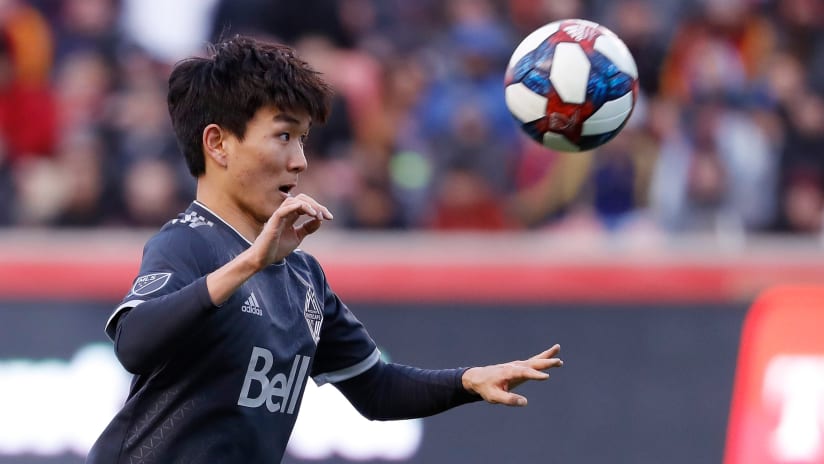The Vancouver Whitecaps and Seattle Sounders will likely make a bit of MLS history on Saturday.
If Vancouver playmaker Inbeom Hwang and Seattle center back Kim Kee-hee both play at BC Place, it will mark the first time that two South Koreans will oppose each other in an MLS match. Both players have played every minute of their clubs’ first three matches and both are expected to start Saturday.
It’s not exactly a major milestone, but the Hwang vs. Kim matchup is illustrative. Despite becoming increasingly international over the years, MLS hasn’t signed a significant number of players who developed in the East Asian countries of South Korea, Japan, China and Vietnam.
What gives? A variety of factors, naturally.
First and most obvious is the fact that none of the four East Asian countries export many soccer players. Japan and South Korea send a decent amount of talent around the world, but they’re not exactly producing pros at the scale of Brazil or Argentina. There’s just not a huge pool of players for MLS to draw from.
Another issue? Both MLS and Japan’s J-League, widely considered the most well-rounded league in the region, view themselves as superior to the other. The J-League naturally includes large numbers of Japanese players and draws substantially from South Korea. Plenty of J-League players have the talent to contribute in MLS, but there’s not much motivation for them to move halfway around the world for what they perceive as a lateral move. Similarly, there’s not much incentive for MLS teams to sign players from the J-League, Korea, China or Vietnam if they’re not significantly better than the average American or Canadian. Why use an international slot on a player who will have to make major professional and personal adjustments if they’re not bringing much more to the table than a domestic option?
“Both leagues sincerely and truly believe they’re better than the other,” said Takehiko Nakamura, Asian market consultant for MLS and the founder and CEO of Blue United, a sports marketing firm that owns and runs the annual Pacific Rim Cup preseason tournament in Hawaii between MLS and J-League clubs. “Both leagues are looking at Europe and the players’ dream is to go to Europe. The top-tier players usually aim for that, then when you look at the second-tier, it’s not good enough for either side.”
Money also plays a role. Like MLS, the J-League pays good wages. Signing players from there, whether they’re Japanese, Korean or any other nationality, is often “cost prohibitive and inefficient” relative to what they add to a roster, Sounders GM and president of soccer Garth Lagerwey told MLSsoccer.com.
Nakamura noted that finances aren’t as big of a stumbling block as they used to be due to the influx of Targeted Allocation Money into MLS, but he acknowledged they still play a role in limiting the number of East Asian players who move to the league. Other factors? Differing styles of play (he characterized the J-League as a bit more technical and a bit slower than MLS) and the massive cultural and geographic divides between East Asia and North America.
Logistically, he noted, it’s easier for an MLS team to go scout in Europe or South America than in Asia. The language barriers are often lower, travel is often easier and, as such, the relationships between MLS teams and clubs and agents in Europe and South America are often more built out than they are in Asia.
“It’s a different story going to Asia,” said Nakamura. “It’s an organic thing that the U.S. and Canada would build a better relationship with Europe or South America.”
Of course, it makes more sense for some MLS clubs to scout in East Asia than others. Vancouver might be atop that list. The ‘Caps have been more active in recruiting South Korean and Japanese internationals than just about all of their MLS counterparts, notably signing longtime South Korean national teamer Y.P. Lee in 2012 and bringing Japanese players Daigo Kobayashi and Masato Kudo to MLS in 2013 and 2016, respectively.
As Vancouver VP of soccer operations Greg Anderson told MLSsoccer.com earlier this week, the ‘Caps are uniquely positioned in MLS to get solid players out of the East Asian market. Vancouver is geographically closer to the region than any other MLS team and has significant Chinese and, to a slightly lesser extent, Korean and Japanese populations.
“Our geography and the makeup of our city makes it maybe a smoother transition or easier step for some of the players to come,” Anderson said.
Vancouver used both of those factors when pitching themselves to Hwang, who reportedly chose the ‘Caps over several European options this winter. The 22-year-old Designated Player has been one of the more exciting additions to the league this season, smoothly running Vancouver’s attack and recording one assist in his three matches. As MLS continues to add more money and as scouting networks at clubs all over the league continue to expand and mature, more players like Hwang – who spent his entire career in the Korean first and second divisions prior to moving to Vancouver – could end up in MLS.
“The Pacific Rim, East Asia, it’s a new region that’s still untapped [from a soccer perspective],” said Nakamura. “I think it’s a good market [for MLS] and my hope is that both sides would collaborate more in a tangible way in the future.”













